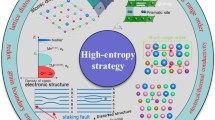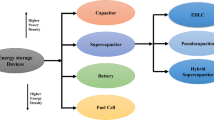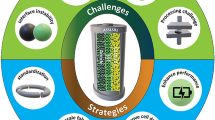Abstract
Compared with other energy storage devices, supercapacitors have superior qualities, including a long cycling life, fast charge/discharge processes, and a high safety rating. The practical use of supercapacitor devices is hindered by their low energy density. Here, we briefly review the factors that influence the energy density of supercapacitors. Furthermore, possible pathways for enhancing the energy density via improving capacitance and working voltage are discussed. In particular, we offer our perspective on the most exciting developments regarding high-energy-density supercapacitors, with an emphasis on future trends. We conclude by discussing the various types of supercapacitors and highlight crucial tasks for achieving a high energy density.
摘要
超级电容器与其他能量存储装置相比具有突出的优势, 例如长循环寿命, 快速的充放电过程以及安全性. 然而, 由于超级电容器仍然面临着能量密度低的问题, 这限制了其广泛应用. 我们简要综述了影响超级电容器能量密度的因素, 讨论了如何通过提高电容和工作电压来改善能量密度. 特别地,我们总结了最近在高能量密度超级电容器方面的一些令人激动的进展, 并着重分析了其未来发展趋势. 最后我们讨论了多种多样的超级电容器, 并提出了一些关键的设计以获得高能量密度.
Similar content being viewed by others
References
Armand M, Tarascon JM. Building better batteries. Nature, 2008, 451: 652–657
Miller JR, Simon P. Materials science: electrochemical capacitors for energy management. Science, 2008, 321: 651–652
Bonaccorso F, Colombo L, Yu G, et al. Graphene, related twodimensional crystals, and hybrid systems for energy conversion and storage. Science, 2015, 347: 1246501–1246501
Li W, Zeng L, Wu Y, et al. Nanostructured electrode materials for lithium-ion and sodium-ion batteries via electrospinning. Sci China Mater, 2016, 59: 287–321
Simon P, Gogotsi Y. Materials for electrochemical capacitors. Nat Mater, 2008, 7: 845–854
Wang G, Zhang L, Zhang J. A review of electrode materials for electrochemical supercapacitors. Chem Soc Rev, 2012, 41: 797–828
Yan J, Wang Q, Wei T, et al. Recent advances in design and fabrication of electrochemical supercapacitors with high energy densities. Adv Energy Mater, 2014, 4: 1300816
Wu S, Zhu Y. Highly densified carbon electrode materials towards practical supercapacitor devices. Sci China Mater, 2017, 60: 25–38
Béguin F, Presser V, Balducci A, et al. Carbons and electrolytes for advanced supercapacitors. Adv Mater, 2014, 26: 2219–2251
Hao L, Li X, Zhi L. Carbonaceous electrode materials for supercapacitors. Adv Mater, 2013, 25: 3899–3904
Largeot C, Portet C, Chmiola J, et al. Relation between the ion size and pore size for an electric double-layer capacitor. J Am Chem Soc, 2008, 130: 2730–2731
Zhu Y, Murali S, Stoller MD, et al. Carbon-based supercapacitors produced by activation of graphene. Science, 2011, 332: 1537–1541
Hou J, Cao T, Idrees F, et al. A co-sol-emulsion-gel synthesis of tunable and uniform hollow carbon nanospheres with interconnected mesoporous shells. Nanoscale, 2016, 8: 451–457
Xu J, Tan Z, Zeng W, et al. A hierarchical carbon derived from sponge-templated activation of graphene oxide for high-performance supercapacitor electrodes. Adv Mater, 2016, 28: 5222–5228
Kim TY, Jung G, Yoo S, et al. Activated graphene-based carbons as supercapacitor electrodes with macro- and mesopores. ACS Nano, 2013, 7: 6899–6905
Sevilla M, Fuertes AB. Direct synthesis of highly porous interconnected carbon nanosheets and their application as high-performance supercapacitors. ACS Nano, 2014, 8: 5069–5078
Wang H, Xu Z, Kohandehghan A, et al. Interconnected carbon nanosheets derived from hemp for ultrafast supercapacitors with high energy. ACS Nano, 2013, 7: 5131–5141
Xu Y, Lin Z, Zhong X, et al. Holey graphene frameworks for highly efficient capacitive energy storage. Nat Commun, 2014, 5: 4554
Li Y, Li Z, Shen PK. Simultaneous formation of ultrahigh surface area and three-dimensional hierarchical porous graphene-like networks for fast and highly stable supercapacitors. Adv Mater, 2013, 25: 2474–2480
Lin T, Chen IW, Liu F, et al. Nitrogen-doped mesoporous carbon of extraordinary capacitance for electrochemical energy storage. Science, 2015, 350: 1508–1513
Chen LF, Zhang XD, Liang HW, et al. Synthesis of nitrogen-doped porous carbon nanofibers as an efficient electrode material for supercapacitors. ACS Nano, 2012, 6: 7092–7102
Xia W, Qu C, Liang Z, et al. High-performance energy storage and conversion materials derived from a single metal–organic framework/ graphene aerogel composite. Nano Lett, 2017, 17: 2788–2795
Zhang W, Xu C, Ma C, et al. Nitrogen-superdoped 3D graphene networks for high-performance supercapacitors. Adv Mater, 2017, 29: 1701677
Qie L, Chen W, Xu H, et al. Synthesis of functionalized 3D hierarchical porous carbon for high-performance supercapacitors. Energy Environ Sci, 2013, 6: 2497
Zhong M, Kim EK, McGann JP, et al. Electrochemically active nitrogen-enriched nanocarbons with well-defined morphology synthesized by pyrolysis of self-assembled block copolymer. J Am Chem Soc, 2012, 134: 14846–14857
Guo DC, Mi J, Hao GP, et al. IL C16mimBF4 assisted synthesis of poly(benzoxazine-co-resol)-based hierarchically porous carbons with superior performance in supercapacitors. Energy Environ Sci, 2013, 6: 652–659
Hou J, Cao C, Idrees F, et al. Hierarchical porous nitrogen-doped carbon nanosheets derived from silk for ultrahigh-capacity battery anodes and supercapacitors. ACS Nano, 2015, 9: 2556–2564
Qian W, Sun F, Xu Y, et al. Human hair-derived carbon flakes for electrochemical supercapacitors. Energy Environ Sci, 2014, 7: 379–386
Hou J, Cao C, Ma X, et al. From rice bran to high energy density supercapacitors: a new route to control porous structure of 3D carbon. Sci Rep, 2015, 4: 7260
Zhu J, Shan Y, Wang T, et al. A hyperaccumulation pathway to three-dimensional hierarchical porous nanocomposites for highly robust high-power electrodes. Nat Commun, 2016, 7: 13432
Hou J, Jiang K, Tahir M, et al. Tunable porous structure of carbon nanosheets derived from puffed rice for high energy density supercapacitors. J Power Sources, 2017, 371: 148–155
Kang D, Liu Q, Gu J, et al. “Egg-box”-assisted fabrication of porous carbon with small mesopores for high-rate electric double layer capacitors. ACS Nano, 2015, 9: 11225–11233
Hou J, Jian K, Wei R, et al. Popcorn-derived porous carbon flakes with an ultrahigh specific surface area for superior performance supercapacitors. ACS Appl Mater Interfaces, 2017, 9: 30626–30634
Chen C, Zhang Y, Li Y, et al. All-wood, low tortuosity, aqueous, biodegradable supercapacitors with ultra-high capacitance. Energy Environ Sci, 2017, 10: 538–545
Biswal M, Banerjee A, Deo M, et al. From dead leaves to high energy density supercapacitors. Energy Environ Sci, 2013, 6: 1249
Zhao Y, Liu J, Horn M, et al. Recent advancements in metal organic framework based electrodes for supercapacitors. Sci China Mater, 2018, 61: 159–184
Sheberla D, Bachman JC, Elias JS, et al. Conductive MOF electrodes for stable supercapacitors with high areal capacitance. Nat Mater, 2017, 16: 220–224
Khalid S, Cao C, Wang L, et al. Microwave assisted synthesis of porous NiCo2O4 microspheres: application as high performance asymmetric and symmetric supercapacitors with large areal capacitance. Sci Rep, 2016, 6: 22699
Mahmood N, Tahir M, Mahmood A, et al. Chlorine-doped carbonated cobalt hydroxide for supercapacitors with enormously high pseudocapacitive performance and energy density. Nano Energy, 2015, 11: 267–276
Ali Z, Tahir M, Cao C, et al. Solid waste for energy storage material as electrode of supercapacitors. Mater Lett, 2016, 181: 191–195
Salunkhe RR, Kaneti YV, Yamauchi Y. Metal–organic frameworkderived nanoporous metal oxides toward supercapacitor applications: progress and prospects. ACS Nano, 2017, 11: 5293–5308
Idrees F, Hou J, Cao C, et al. Template-free synthesis of highly ordered 3D-hollow hierarchical Nb2O5 superstructures as an asymmetric supercapacitor by using inorganic electrolyte. Electrochim Acta, 2016, 216: 332–338
Zhang X, Zhang H, Lin Z, et al. Recent advances and challenges of stretchable supercapacitors based on carbon materials. Sci China Mater, 2016, 59: 475–494
Hao J, Peng S, Qin T, et al. Fabrication of hybrid Co3O4/NiCo2O4 nanosheets sandwiched by nanoneedles for high-performance supercapacitors using a novel electrochemical ion exchange. Sci China Mater, 2017, 60: 1168–1178
Khalid S, Cao C, Wang L, et al. A high performance solid state asymmetric supercapacitor device based upon NiCo2O4 nanosheets//MnO2 microspheres. RSC Adv, 2016, 6: 70292–70302
Zhu Y, Cao C, Tao S, et al. Ultrathin nickel hydroxide and oxide nanosheets: synthesis, characterizations and excellent supercapacitor performances. Sci Rep, 2015, 4: 5787
Khalid S, Cao C, Naveed M, et al. 3D hierarchical MnO2 microspheres: a prospective material for high performance supercapacitors and lithium-ion batteries. Sustain Energy Fuels, 2017, 1: 1795–1804
Zheng C, Cao C, Chang R, et al. Hierarchical mesoporous NiCo2O4 hollow nanocubes for supercapacitors. Phys Chem Chem Phys, 2016, 18: 6268–6274
Khalid S, Cao C, Ahmad A, et al. Microwave assisted synthesis of mesoporous NiCo2O4 nanosheets as electrode material for advanced flexible supercapacitors. RSC Adv, 2015, 5: 33146–33154
Choudhary N, Li C, Moore J, et al. Asymmetric supercapacitor electrodes and devices. Adv Mater, 2017, 29: 1605336
Zheng M, Xiao X, Li L, et al. Hierarchically nanostructured transition metal oxides for supercapacitors. Sci China Mater, 2018, 61: 185–209
Yan J, Fan Z, Sun W, et al. Advanced asymmetric supercapacitors based on Ni(OH)2/graphene and porous graphene electrodes with high energy density. Adv Funct Mater, 2012, 22: 2632–2641
Owusu KA, Qu L, Li J, et al. Low-crystalline iron oxide hydroxide nanoparticle anode for high-performance supercapacitors. Nat Commun, 2017, 8: 14264
Boruah BD, Misra A. Internal asymmetric tandem supercapacitor for high working voltage along with superior rate performance. ACS Energy Lett, 2017, 2: 1720–1728
Kim M, Kim J. Development of high power and energy density microsphere silicon carbide–MnO2 nanoneedles and thermally oxidized activated carbon asymmetric electrochemical supercapacitors. Phys Chem Chem Phys, 2014, 16: 11323
Qiu Y, Li G, Hou Y, et al. Vertically aligned carbon nanotubes on carbon nanofibers: a hierarchical three-dimensional carbon nanostructure for high-energy flexible supercapacitors. Chem Mater, 2015, 27: 1194–1200
Liu C, Yu Z, Neff D, et al. Graphene-based supercapacitor with an ultrahigh energy density. Nano Lett, 2010, 10: 4863–4868
Hwang JY, El-Kady MF, Wang Y, et al. Direct preparation and processing of graphene/RuO2 nanocomposite electrodes for highperformance capacitive energy storage. Nano Energy, 2015, 18: 57–70
Wu ZS, Ren W, Wang DW, et al. High-energy MnO2 nanowire/ graphene and graphene asymmetric electrochemical capacitors. ACS Nano, 2010, 4: 5835–5842
Ji J, Zhang LL, Ji H, et al. Nanoporous Ni(OH)2 thin film on 3D ultrathin-graphite foam for asymmetric supercapacitor. ACS Nano, 2013, 7: 6237–6243
Zuo W, Li R, Zhou C, et al. Battery-supercapacitor hybrid devices: recent progress and future prospects. Adv Sci, 2017, 4: 1600539
Li B, Dai F, Xiao Q, et al. Nitrogen-doped activated carbon for a high energy hybrid supercapacitor. Energy Environ Sci, 2016, 9: 102–106
Lim E, Jo C, Kim H, et al. Facile synthesis of Nb2O5@Carbon core–shell nanocrystals with controlled crystalline structure for highpower anodes in hybrid supercapacitors. ACS Nano, 2015, 9: 7497–7505
Wang Y, Luo J, Wang C, et al. Hybrid aqueous energy storage cells using activated carbon and lithium-ion intercalated compounds. J Electrochem Soc, 2006, 153: A1425
Shen L, Lv H, Chen S, et al. Peapod-like Li3VO4/N-doped carbon nanowires with pseudocapacitive properties as advanced materials for high-energy lithium-ion capacitors. Adv Mater, 2017, 29: 1700142
Ding J, Wang H, Li Z, et al. Peanut shell hybrid sodium ion capacitor with extreme energy–power rivals lithium ion capacitors. Energy Environ Sci, 2015, 8: 941–955
Jabeen N, Hussain A, Xia Q, et al. High-performance 2.6 V aqueous asymmetric supercapacitors based on in situ formed Na0.5MnO2 nanosheet assembled nanowall arrays. Adv Mater, 2017, 29: 1700804
Peng S, Li L, Wu HB, et al. Controlled growth of NiMoO4 nanosheet and nanorod arrays on various conductive substrates as advanced electrodes for asymmetric supercapacitors. Adv Energy Mater, 2015, 5: 1401172
Li R, Wang Y, Zhou C, et al. Carbon-stabilized high-capacity ferroferric oxide nanorod array for flexible solid-state alkaline battery-supercapacitor hybrid device with high environmental suitability. Adv Funct Mater, 2015, 25: 5384–5394
Li K, Zhang J. Recent advances in flexible supercapacitors based on carbon nanotubes and graphene. Sci China Mater, 2018, 61: 210–232
Qin J, Zhou F, Xiao H, et al. Mesoporous polypyrrole-based graphene nanosheets anchoring redox polyoxometalate for all-solidstate micro-supercapacitors with enhanced volumetric capacitance. Sci China Mater, 2018, 61: 233–242
Zhang J, Zhao XS. On the configuration of supercapacitors for maximizing electrochemical performance. ChemSusChem, 2012, 5: 818–841
Acknowledgements
This work was financially supported by the National Natural Science Foundation of China (21371023).
Author information
Authors and Affiliations
Corresponding author
Additional information
Chuanbao Cao is currently the chief responsible professor of the School of Materials Science and Engineering, Director of Research Center of Materials Science of Beijing Institute of Technology (BIT), China. His research is focused on the electrochemical energy storage and conversion including electrode materials of super-capacitors, lithium ion battery, and photo-electrochemical materials. Until now, he has published more than 300 peer-reviewed research papers, holds or has filed 50 patents and patent applications.
Rights and permissions
About this article
Cite this article
Wu, Y., Cao, C. The way to improve the energy density of supercapacitors: Progress and perspective. Sci. China Mater. 61, 1517–1526 (2018). https://doi.org/10.1007/s40843-018-9290-y
Received:
Accepted:
Published:
Issue Date:
DOI: https://doi.org/10.1007/s40843-018-9290-y




